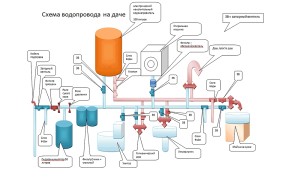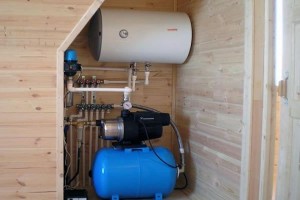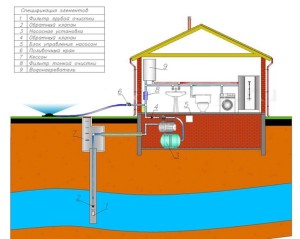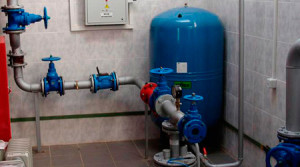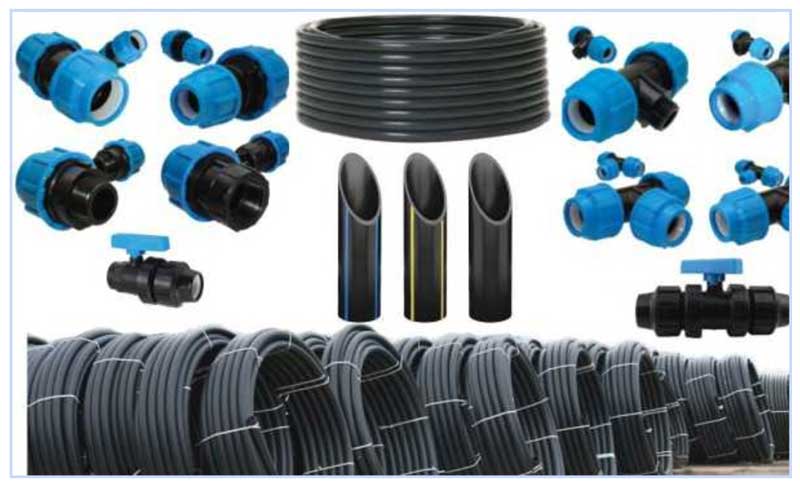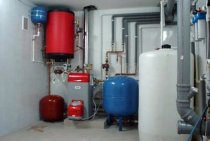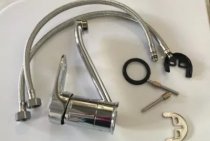Types of drainage systems
When taking water from a direct source, one must not forget that the used water must be diverted somewhere. Today there are three types of drainage system:
- City or local sewer network;
- Individual or local treatment facilities with subsequent discharge onto the terrain or into a reservoir;
- Storage tanks with further removal by sewage trucks.
In the direct arrangement of cottage settlements, it is often necessary to deal with local treatment facilities, a certain area is allocated for them, and discharge is agreed upon. In the form of treatment facilities, in this case, deep cleaning stations are used that help purify water with aerobic bacteria (active sludge).
Activated sludge is used as an oxidizing agent for organic compounds. The essence of deep cleaning is the removal of suspended particles from wastewater, the oxidation of organic compounds, the removal of nitrogen and phosphorus. Disinfection is performed at the moment of water discharge onto the relief and into the reservoir. The performance of the station determines the daily intake of effluents. It should be noted that from one cottage it is possible to discharge 1-1.5 m³ of wastewater.
The implementation of the reception of wastewater treatment facilities is impossible without a sewer network, which is divided into intra-quarter (collector), local (cottage area).
It is desirable that the entire sewer network be designed by gravity, from the house to the sewage pumping station of the treatment plant. Wells are installed at turns, junctions and for the purpose of control on the sewer network. If it is not possible to provide a slope for gravity drainage in certain areas, a pressure branch can be used. In order to collect and pump wastewater, a pumping well is installed at the very beginning of the pressure branch.
Water from a residential building can be supplied to a sewer well through a pressure branch. To ensure pressure sewerage from each individual house, compact pumping stations are used, which are installed directly in the basement, or a pump well is provided at the very outlet from a particular house.
Thus, water supply and sanitation are indispensable utilities. The drainage system contributes to the maintenance of the necessary sanitary standards in a particular settlement. After all, water disposal is a guarantee of cleanliness and an important element of our modern life, both in the city and in the countryside.
Possible water supply options
The water supply of a private house in the absence of a main water supply system will have to be created from scratch. And you can do it using the following methods:
1. drill a well;
2. dig a well;
3. take advantage of the river that flows nearby, redirecting some of its flow into the house through a purification system;
4. create your own storage in the form of tanks that are buried in the ground, in which imported water will be stored.
Also, as an alternative, it is possible to consider the collection of melted and rainwater in tanks to be used for needs after pre-treatment. However, since it does not rain all the time, this option cannot be the main one. It can be used in addition to save some money on the import of clean liquid.
Naturally, the choice here will be determined by the location of the house, as well as the accompanying conditions.
1. Water supply of a country house from a well will be the most ideal option if a small family lives in the house. There may be problems with siltation in case of large and frequent water intake.
2. The well allows you to take more water with little or no consequences. However, this is the case if the well is made with high quality, protected from rainwater and has protection from possible soil destruction. You will also need to take into account the passage of groundwater. In some cases, they can be located very deep, which will make digging a well unprofitable in comparison with a well. In addition, the water from the well can simply go away, which will become a big problem.
3. The nearby river, at first glance, may seem like an inexhaustible source of water. However, there are many disadvantages in this case. The most basic of them is the tangible high cost of the necessary cleaning. It will be necessary to build a filtration complex, and its operation will be quite expensive. In addition, this source without purification will go only for technical needs.
4. Reservoir for storing imported water. To do this, you will need to buy several large stainless steel or plastic tanks, immerse them in the ground. If necessary, it can be connected by a piping system, after which imported water will be delivered to the house using a pump. In some cases, you can do without a pump, for this it is necessary to ensure the gravity flow of water - the tanks are installed at a certain height. However, in the case of using special plumbing equipment, the use of a pump will be mandatory, because a certain minimum pressure is required for their full operation. There is one significant drawback here - the delivery of water will require sufficient financial resources, which for many will be an unacceptable solution.
Plumbing scheme in the country
We draw up project documentation
Drawing up a project may be necessary if a major overhaul of a residential building with redevelopment is taking place or it has recently been built. To develop it on the basis of the received technical conditions, you can contact private architectural firms or the designers of the organization that owns the water source.
When compiling it, the number of residents in the house, the volume of water consumed, the location of bathrooms and household appliances, and the presence of other sources of water supply are taken into account. When developing a project, the design organization will need a site and house plan (drawings of a residential building and a topographic survey of the site), the type of plumbing used in housing, and a list of operational requirements.
The finished project should provide answers to questions on:
- the choice of the layout of the distribution of cold and hot water when using a water intake source for the heating system;
- choice of materials and dimensions of pipes;
- the thickness of the screed, if the water main is located in the floor;
- the amount of materials and plumbing fixtures required for installation work;
- pressure - whether booster pumps are required for wells.
The customer must receive from the organization that has the right to draw up project documentation, a document with the following content:
- title page with general data and explanatory note;
- master plan with the layout of the main water main;
- a wiring diagram for the water line in the house, indicating the main nodes and points for the placement of valves;
- axonometric diagram of the water supply and boiler room;
- specification of the materials used and plumbing fittings.

Fig.4 Water connection project - example
Water supply of a country house
At the time of installation of water supply in a country house, the main parameter is the choice of a water source. Let's look at the sources of water supply that are used in the process of installing a suburban water supply.
Well
The most accessible and common method of extracting water is considered to be a well. Its depth depends on the location and generally does not exceed 10 - 15 m. The advantage of the well is its low cost.When choosing a well as a source of water for water supply, its disadvantages must also be taken into account. Water can be insufficiently clean, contain various bacteria, nitrates, heavy metals. As a result, before using such water for drinking purposes, chemical and bacteriological analyzes are required. Therefore, it is recommended to include water purification filters in the water supply system. Another disadvantage is that there are no guarantees that the dug well will not silt up or dry out after a while.
When using a pumping system in winter, it will be necessary to equip an insulated “house” above the well, which can protect the water supply system from possible freezing.
Compact equipment placement
Well
The process of drilling a well will be a more expensive method of extracting water. By depth, two types of wells can be distinguished:
- A sandy well is drilled to a shallow depth (up to 50 m). The quality of the water in this well is much better than in the well, but it is still necessary to analyze the water before using it, since surface, groundwater can sometimes get into the sandy aquifer. At the bottom of the well, a mesh filter will be required to purify water from sand and other solid impurities. According to sanitary standards, the water source should be no closer than 30 meters from treatment facilities, waste disposal sites and other sources of pollution.
- An artesian well is considered the best solution for water supply to a country house. Water intake in it is carried out from a limestone layer, which, depending on the location, can lie at a depth of several hundred meters. The water in such a layer is under pressure, as a result of which the static water level will be less than the depth of the well itself. So, from an artesian well, it is possible to obtain more than 10 m³ / h of water, and this is enough to supply water to several cottages. Basically, the water does not need additional purification, it is suitable for drinking, since it can be protected from surface water by impervious layers of soil. An artesian well can serve 15-30 years, and usually there are no problems with it during operation. Above the well, a metal sealed well is installed to protect against possible groundwater, easy maintenance of this well.
It is necessary to pay attention to the fact that the water that is in the limestone aquifers is the property of the state, as a result of this, before starting to drill a well, you need to obtain an appropriate permit. The next step in the construction of a water supply system is the choice of a pump, with which water rises from a well or well and is delivered to the house to all water points
When extracting water by the borehole method, there is only one option - a borehole pump, its parameters are selected depending on the static, dynamic water levels in the well. During the extraction of water from the well, pumping stations are used, as well as submersible pumps.
The next step in the construction of a water supply system is the choice of a pump with which water rises from a well or well and is delivered to the house to all points of water analysis. When extracting water by the borehole method, there is only one option - a borehole pump, its parameters are selected depending on the static, dynamic water levels in the well. During the extraction of water from the well, pumping stations are used, as well as submersible pumps.
Pumping stations can lift water from 7-8 m, and if the depth of the well exceeds this value, submersible pumps are used. It should be noted that the above pumps are afraid of "dry running", namely, operation without water, as a result of which it is necessary to install "dry running" sensors that turn off the pump when the water level in the well or well falls below the permissible level.
https://youtube.com/watch?v=q9xeuUNJMbU
The pumping station, as a rule, already includes a small hydraulic accumulator and pump control automation, and this greatly facilitates their installation. In case the accumulator of the pumping station is not enough, an additional membrane tank with a large volume can be added to the system.
In the case of using a submersible pump, control automation and a hydraulic accumulator must be purchased separately.
Features of downhole equipment and its use
The main element of this equipment will be a pump that will lift liquid from the required depth.
That is why it is so important to choose the right pump so that it meets the required parameters. That is why you should consult with those who performed the drilling, so as not to make a mistake in choosing
And it is best to order the work on a turnkey basis. Such an approach will ensure that everything will be done wisely with all the necessary calculations. As a result, there will be no problems with the water supply, and you will clearly know that at any time you can contact the appropriate organization to resolve problems under the guarantee.
If the decision is made to independently purchase and install the pump, then it will be necessary to perform the necessary calculations in order to calculate its power depending on the depth and water consumption. Also, pumping equipment will need to be delivered to the deep layers. To do this, you will need a special lift, which should also be purchased. You can also use a manual or electric winch. In addition, a cable and hose of the appropriate length will be needed to ensure the functioning of the pumping equipment.
The plumbing system will require considerable space, as well as protection from various weather conditions, especially in areas where frost is rampant. It is for this that a separate room should be organized above the well in order to ensure its normal functioning and maintenance. At the same time, such a room must be properly equipped and insulated.
When selecting pumping equipment, it should also be taken into account that the water pressure for normal water supply must be stable. This means that it will be necessary to select a sufficiently powerful pump or build a system with a storage unit that will allow you to create the desired pressure in the system.
Well Organization Scheme
How to deliver water to the house
In some cases, it is possible to arrange a well right in the house. To do this, a well is made even before the construction of the house, which makes it possible to carefully equip everything and supply the house with water without any problems. This approach is the most rational, however, most people drill a well at a certain distance from the building. This makes it possible to irrigate the site, as well as supply water to the house, but here it becomes necessary to deliver water to the house, that is, water supply is needed.
Plumbing can be made in three types:
1. internal plumbing that functions in the house;
2. plumbing, acting before entering the house;
3. a system designed to draw water from a well.
The internal water supply device will include a whole set of various pipes, adapters, taps, as well as other devices and appliances that are needed for comfortable use.
The water supply system, which is in operation before entering the house, will have to ensure the delivery of the liquid, that is, it will connect the well equipment, as well as the internal water supply. The equipment will be a borehole pump, as well as other elements necessary to supply fluid from the well to the water supply.
Types of water supply systems
Water supply systems are classified according to the main features. By appointment:
- water supply system for populated areas;
- industrial water supply system;
- agricultural water supply system;
- fire water supply system;
- combined water supply system.
In the modern water supply system, plastic pipes are used in the construction of water pipes. Today, among pipes made of cast iron, steel, fiberglass, they are distinguished by the greatest reliability, environmental friendliness and durability.
For external water supply networks, polyethylene pipes are used, as well as PVC pipes.
Modern materials amaze even the most demanding consumer, as they are distinguished by high quality, durability, strength, relatively low weight, and flexibility.
Expansion tank
Types and methods of water supply of a private house
From the standpoint of the dependence of the source of water supply on external factors, two fundamentally different types of water delivery to the user can be distinguished:
Centralized water supply at home
In fact, the same autonomous, but within the region. In this case, the user does not need to take care of arranging the source of water supply. It is enough to connect (crash) to the central water main.
Connecting the house to the central water supply
All actions are reduced to the phased implementation of a number of requirements, including:
appeal to the regional municipal organization MPUVKH KP "Vodokanal" (Municipal enterprise "Department of water supply and sewerage"), which controls the central highway;
obtaining the technical characteristics of the tie-in. The document contains data on the place where the user's pipe system is connected to the main and its depth. In addition, the diameter of the main pipes is indicated there and, accordingly, instructions for choosing home piping. It also indicates the water pressure indicator (guaranteed water pressure);
get an estimate for connection, which is developed by a utility or contractor;
control the execution of work. Which are also commonly performed by UPKH;
perform a system test.
Advantages of central water supply: convenience, simplicity.
Disadvantages: fluctuating water pressure, doubtful quality of incoming water, dependence on central supplies, high cost of water.
Autonomous water supply at home
It is possible to independently provide water supply to a summer house, private or country house using autonomous water supply. In fact, this is an integrated approach, which includes activities for the installation of a water supply system, starting with providing a source of water supply, ending with its discharge into the sewer.
An autonomous water supply system can be represented as two component subsystems:
water delivery: imported, groundwater, from an open source;
supply to consumption points: gravity, using a pump, with the arrangement of a pumping station.
Therefore, in a generalized form, two water supply schemes can be distinguished: gravity (storage tank with water) and automatic water supply.
Using the container (water tank)
The essence of the autonomous water supply scheme at home is that water is supplied to the tank using a pump or filled manually.
Water flows to the user by gravity. After all the water from the tank has been used, it is refilled to the maximum possible level.
Gravity water supply system - water supply scheme from the storage tank
Its simplicity speaks in favor of this method, it is suitable if water is required from time to time. For example, in a dacha that is not often visited or in a utility room.
Such a water supply scheme, despite its simplicity and cheapness, is too primitive, inconvenient and, moreover, creates significant weight on the interfloor (attic) floor. As a result, the system has not found wide distribution, it is more suitable as a temporary option.
Using the automatic water supply system
Scheme of automatic water supply of a private house
This diagram demonstrates the operation of a completely autonomous water supply system for a private house. Water is supplied to the system and to the user by means of a system of components.
It is about her that we will talk in more detail.
You can implement a completely autonomous water supply of a private house on your own by implementing one of the schemes. There are several device options to choose from:
1. Water from open sources
Important! Water from most open sources is not suitable for drinking. It can only be used for irrigation or other technical needs.
Obtaining water from an open source requires the creation of sanitary protection of water intake sites and is regulated by the provisions of SanPiN 2.1.4.027-9 "Zones of sanitary protection of water supply sources and water supply systems for household and drinking purposes."
Possible consequences of errors in the development of V&V schemes
Like any initial data, the Water Supply and Sanitation Scheme is the basis for the development and refinement of a large number of regulatory legal acts. In case of making erroneous decisions as part of the V&V Scheme, local governments will have to make significant adjustments to various regulatory legal acts.

Often errors occur due to the fact that V&V Schemes are developed by Auditing companies or one-day companies that entered the market in connection with the opportunities that have opened up and have nothing to do with the design of Water supply and sanitation facilities. The imperfection of the legislation makes it possible for companies that do not have SROs to develop schemes.
Financial instruments
In the Russian Federation, there are a large number of federal and regional targeted programs directly or indirectly aimed at modernizing the water supply and sewerage system.
- The Clean Water Program for 2011-2017
- Housing program for 2011-2015
- Subprogram "Modernization of public infrastructure facilities"
- Program "Development of the water management complex of the Russian Federation in 2012-2020"
- Other federal and regional programs.
Also, at the moment, European financial corporations and banks are actively working on the territory of the Russian Federation, for example, for objects related to reducing the negative impact on the ecological state of water resources, it is possible to attract concessional European loans and gratuitous grants from such international financial organizations as NEFCO and the EBRD, as well as European environmental funds such as NDEP, cross-border cooperation programs are actively developing, European and already Russian banks are implementing preferential lending programs and leasing agreements for production modernization projects aimed at reducing energy costs.
The legislation of the Russian Federation, with appropriate justification, allows you to temporarily stop the imposition of penalties for violations of environmental and sanitary legislation of the Russian Federation and direct these funds to the modernization of technological processes.
With a joint, comprehensive analysis of all financial instruments, taking into account their target indicators, as well as a unified approach, on the scale of municipal districts, when considering the problems of water supply and sanitation facilities, it is possible to build a comprehensive investment program for the modernization of water and sanitation facilities, which would allow targeted distribution of funding for programs between "Water and utilities facilities" and fulfill all the conditions of the Target Programs: ensure the achievement of the required targets, optimize the financial burden on the municipal and regional budgets, and most importantly, provide the population with quality services in the field of WSS and give a significant impetus to the development of agriculture and production. See the concept of the Program Allocation Scheme above.
Which pipe and fittings to choose
As noted above, it is more rational to lay the pipeline using HDPE pipes, which are the most common. Distinctive features of this type of pipes are as follows:
- Products are intended for supply of cold water with a temperature from 0 to 40 C.;
- The range of maximum pressures depends on the diameter and can reach up to 25 atmospheres.
- The HDPE pipeline has a lower hydraulic resistance compared to metal products, which prevents the formation of salt deposits and silt on the walls during water circulation.
- Connection to the mains and pipes inside the house is carried out using compression fittings, which ensure ease of installation, high reliability and tightness of the connection.
- The pipe is supplied in coils of various lengths - this facilitates its transportation and installation.
- The service life of a HDPE pipeline without losing its physical and chemical properties is about 50 years.
- Unlike metals, synthetic materials are resistant to corrosion and most harsh chemicals.
- Low-pressure polyethylene has low thermal conductivity - this prevents the water in the pipes from freezing in cold weather.
- Freezing of pipes rarely leads to rupture - they stretch without losing their integrity.
- Currently, the most common grades are PE80 or PE100, the latter has a high density and is used for the installation of water mains.
Rice. 10 HDPE pipes and fittings - appearance
You can officially connect to the main water supply in a private house after drawing up and signing a large number of documents that must be submitted to the water utility in order to draw up an agreement on connection to the water supply system. To save money, part of the work can be done by hand within an individual site - this is not prohibited by law if the installation was carried out in accordance with the technical specifications.
Creation of an autonomous water supply system
1. Application of an automated pumping station.
This option is best used in the case of a shallow well. The essence of such a system lies in the use of a hydropneumatic tank, which has an average capacity of 100-500 liters. The pump pumps water into this tank, where it accumulates. Such a tank creates the necessary stable pressure, which ensures the pumping of water into the house.
The tank has a relay and a special rubber membrane that allows you to adjust the pressure in the tank. The principle of such a device is as follows: if the tank is full, then the pump is off. With the flow of water, the pumping equipment starts. As a result, the pump will operate in two modes: to replenish stocks in the tank, and also to ensure stable pressure in the system.
The hydropneumatic tank can be located both in the house and directly in the utility room. To connect the home system to the tank, it is necessary to dig a trench where the pipe and cable will be laid to bring electricity. If possible, it is recommended to buy a heating electric cable, which will protect the pipe from freezing in the winter.
2. Installation of the deep pump.
If you choose this option, the pump will direct water to the tank, which will be located at a certain height in the house. In most cases, the storage device is mounted on the second floor of the building, or in the attic. When placing the container in the attic, you must first take care of the insulation of the walls of the tank so that in the winter it does not freeze and become unusable.
Finding the tank at a certain height makes it possible to provide pressure.It can be calculated by equating a meter of water column to a pressure of 0.1 atmospheres. Therefore, it is possible to ensure the creation of the necessary pressure by placing the container at the right height.
Since the water will be used by people as drinking water, it is important that the container is made of food grade plastic or stainless steel. Usually the volume is selected in the range of 0.5-1.5 thousand liters
https://youtube.com/watch?v=WJhLMW6cv58
The choice in favor of a larger volume of the tank is due to the fact that when the electricity is turned off, it will be possible to use the already accumulated liquid for a longer time. Installation of a limit float switch can automate the process, because when the level drops, the pump will turn on
At the same time, attention will need to be paid to choosing the right pump for the system. The use of submersible pumps is recommended when it is necessary to release it below ground level by 10 meters or more.
Since a storage tank will be used in this system, the pumping unit is first of all selected taking into account the maximum fluid consumption, and only then focus on power. Normal pressure must be ensured in the system so that water flows from the tap without interruption. This will allow, for example, to enjoy taking a shower without fear that the pressure will suddenly disappear. To do this, it is necessary to install a check valve so that the pressure does not decrease, and the accumulated reserve didn't go back to earth.
After installing all the necessary elements, it is necessary to carry out the wiring in order to connect the equipment to the appropriate control panel. The system is tested for performance, after which you can start using it.
The main elements of water supply systems
Water supply systems (of a populated area or an industrial enterprise) must provide consumers with water from natural sources, its mandatory purification, and supply to the place of consumption. To accomplish these tasks, you will need the following facilities, which are part of the water supply systems:
- water intake facilities, with their help, water is received from various natural sources;
- pumping stations supply water to places of treatment, storage or consumption;
- facilities for water purification;
- water supply networks that are necessary for transportation, supply of water to the place of its consumption;
- towers, reservoirs, which play the role of regulating, spare tanks in water supply.
Depending on local natural conditions, the nature of water consumption, and economic considerations, the water supply scheme itself, its constituent elements, can vary greatly. The adopted source of water supply strongly influences the water supply scheme, namely, its nature, the quality of the water in it, the power, the distance from it to the object supplied with water. Sometimes several natural sources are used for one object.
Types of wells, their advantages and disadvantages
To create borehole water supply, you can resort to the following options:
1. drilling to sandy springs;
2. drilling to artesian sources.
Both of these options have their pros and cons. So a sand well will solve the problems of water supply in the country, where usually no more than 1.5 cubic meters per hour is required. A similar volume of water is enough for a small house.
However, if we are talking about a country cottage that is used all year round, then the sandy option would not be the best solution. The fact is that the depth of the aquifers of such wells in most cases is less than fifty meters, as a result of which this will not guarantee the purity of the water. Of course, the water in such a well will be an order of magnitude cleaner than in a well, but it may contain various impurities, as well as aggressive compounds.This is due to the fact that the aquifer will be close to surface water. At the same time, such a well will last an average of 10 years, and its productivity will not be very high.
That is why many people in rural areas stop at an artesian well, because it has access to water, which is located at a depth of a hundred meters and even lower. The main advantage of this option will be the highest quality of water, as well as the possibility of its unlimited use. From such a well, you can safely pump out up to 10 cubic meters per hour. This allows you to fully supply a huge plot of farmland together with a large cottage. In addition, such a source is capable of serving for more than fifty years, even in the case of its maximum load. But such a pleasure will be quite expensive, because it will be necessary to invite specialists with modern equipment.
Centralized water supply
By choosing this method, you get the maximum convenience and ease of connecting your home to the system. For this purpose, you will need to obtain permission, for this you need to contact the necessary authorities at your place of residence. Having received permission, you are provided with such technical conditions that you must adhere to in your work. These specifications state:
- the scheme to be followed at the time of work;
- a site where it is possible to connect to the most centralized system;
- depth;
- water pressure;
- Additional Information.
Advantages and disadvantages of centralized water supply
Centralized water supply at home has the following positive aspects:
- all actions related to the maintenance of the system are assigned to the relevant organizations, for which you need to pay the assigned cost every month;
- connection is a simple process;
- power outages do not affect the water supply system itself;
- direct use of water does not imply restrictions.
But for those who decide to choose this method of water supply at home, you need to be aware of some disadvantages. This:
House water distribution
- under certain circumstances, there may be interruptions in the operation of the system;
- water quality in some regions is not always very good;
- most systems are heavily worn, which is the reason for the presence of rust, frequent repairs.
Problems faced by the customer when developing schemes
- Each settlement solves its problems on its own, every year programs are prepared, surveys are carried out, holes are patched up, and budget money is spent. However, the problem remains the same.
- 30% of competitions and auctions for design work have to be canceled due to the incompleteness of the terms of reference, the incommensurability of the timing, cost and required scope of work.
- The result of an unqualified development of V&V schemes is an enlarged concept based on a superficial analysis of the existing situation, and not an accurate engineering calculation.
- The development of a water supply and sanitation scheme is often carried out by consulting and auditing agencies, and not by companies involved in the design of specialized water supply and sanitation facilities.
- The lack of a water supply and sanitation scheme approved in accordance with the established procedure will not allow the implementation of large investment projects in the field of housing and communal services in the future.
- The inability to keep track of the constantly changing technologies in the industry and modern dispatching and monitoring systems.
- Lack of funding.
